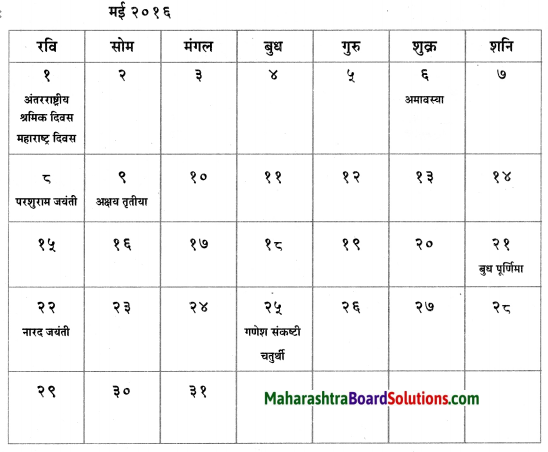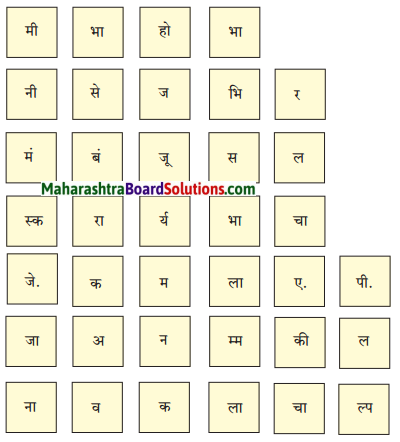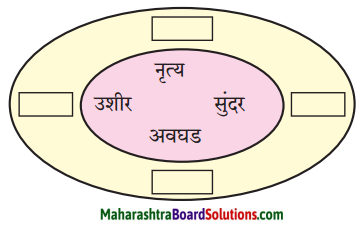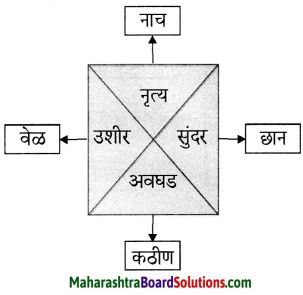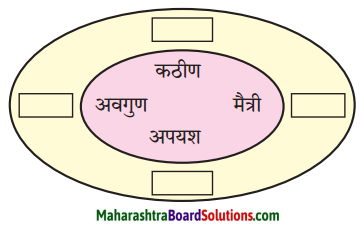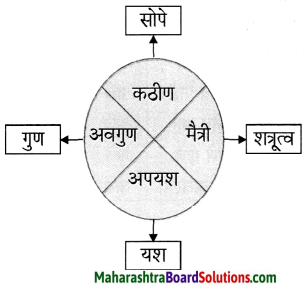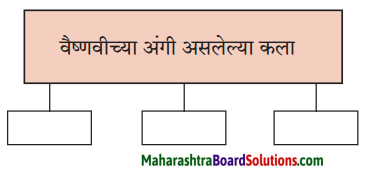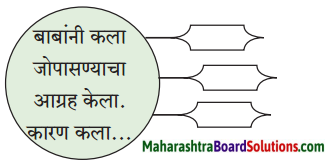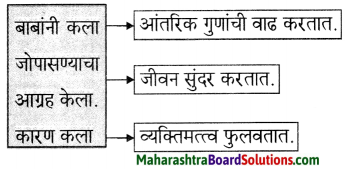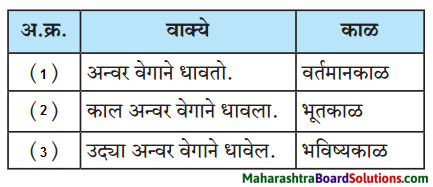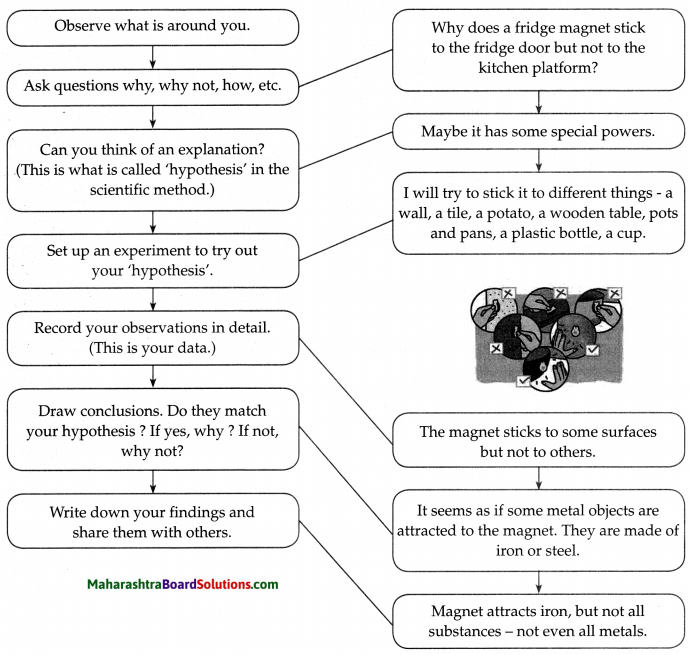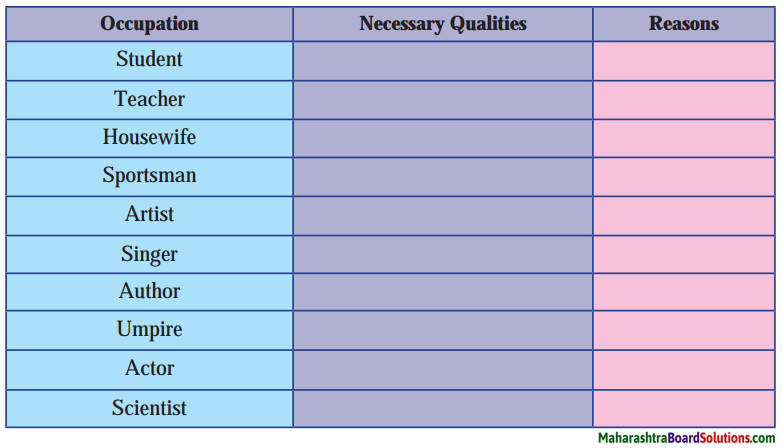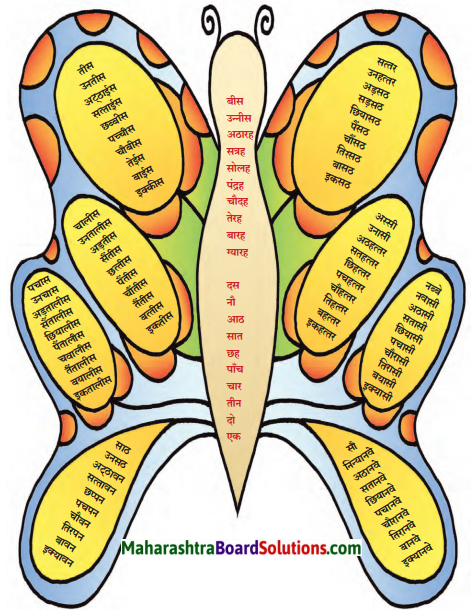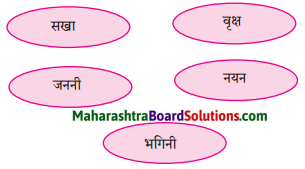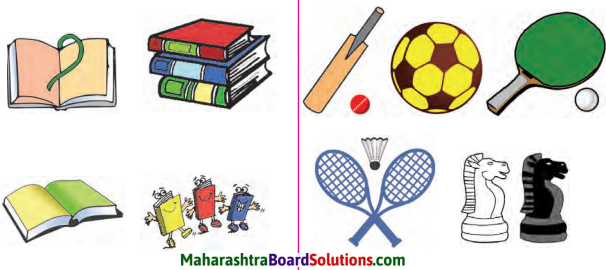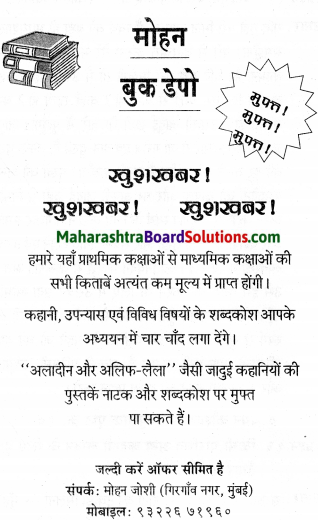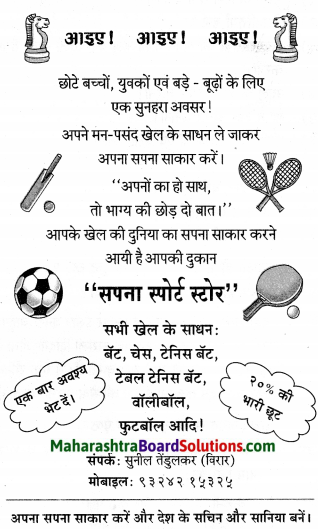Balbharti Maharashtra State Board Class 6 Marathi Solutions Sulabhbharati Chapter 16 मुक्या प्राण्यांची कैफियत Notes, Textbook Exercise Important Questions and Answers.
Maharashtra State Board Class 6 Marathi Solutions Chapter 16 मुक्या प्राण्यांची कैफियत
Marathi Sulabhbharti Class 6 Solutions Chapter 16 मुक्या प्राण्यांची कैफियत Textbook Questions and Answers
1. तक्रार व वनचर यांच्या माध्यामातून जोड्या पूर्ण करा.
प्रश्न 1.
तक्रार व वनचर यांच्या माध्यामातून जोड्या पूर्ण करा.
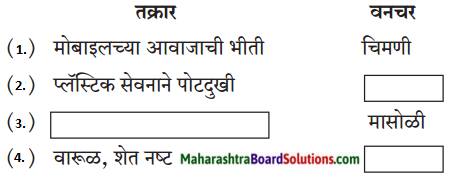
उत्तर:
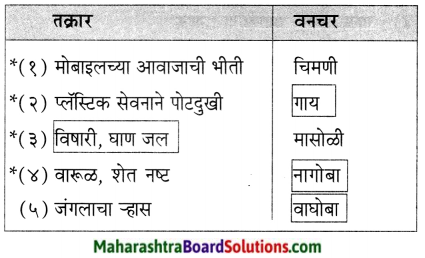
2. दोन-तीन वाक्यांत उत्तरे लिहा.
प्रश्न अ.
या पाठात कोणाकोणात संवाद झालेला आहे?
उत्तर:
या पाठात गाय, चिमणी, मासोळी, नागोबा, सर्व प्राणी व माणूस यांच्यात संवाद झालेला आहे.
![]()
प्रश्न आ.
चिमणीला कोणता त्रास होतो?
उत्तर:
मोबाईलच्या आवाजाने चिमणीची छाती धडधडून तिचा जीव व्याकूळ होतो. तिला काही सुचत नाही.
प्रश्न इ.
गाईचे डोळे का पाणावले?
उत्तर:
माणसाने टाकलेले प्लॅस्टिक घासाबरोबर गाईच्या पोटात जाऊन तिचे पोट दुखू लागले व तिचे डोळे पाणावले.
प्रश्न ई.
मासोळीने आपली कोणती समस्या मांडली आहे?
उत्तर:
सांडपाणी व रसायने टाकून माणसाने पाणी विषारी करून टाकले आहे. ते पाणी घाण असल्याने पिण्यासारखे नाही. म्हणून जलचर तडफडत आहेत. ही समस्या मांडली आहे.
![]()
प्रश्न उ.
नागोबाची तक्रार कोणती आहे?
उत्तर:
गवत, शेती नष्ट झाल्याने वारूळेही राहिली नाहीत. मानवाने पर्यावरणाचा -हास केला आहे. नागोबांना पकडून नागपंचमीला दूध, लाया दिले जाते. हे त्याचे अन्न नाही. अंधश्रद्धेपोटी माणूस नागांच्या जीवावर उठला आहे. ही तक्रार आहे.
3. घोटभर, मैलभर, तासभर, कणभर, चमचाभर हे शब्द वापरून वाक्ये लिहा.
प्रश्न 1.
घोटभर, मैलभर, तासभर, कणभर, चमचाभर हे शब्द वापरून वाक्ये लिहा.

उत्तर:
- घोटभर – उन्हाळ्यात घोटभर पाणी मिळाले तरी समाधान वाटते.
- मैलभर – मैलभर अंतर चालून गेल्यावर एक देऊळ लागले.
- तासभर – झाकीरने तासभर तबला वाजविला.
- कणभर – कणभरही अन्न वाया जाऊ देऊ नये.
- चमचाभर- चमचाभर औषध तापाला घालविते.
- टिचभर – मुंबईत टिचभर ही जागा शिल्लक नाही.
- रात्रभर – यात्रेकरू रात्रभर डोंगर चढत होते.
4. कोण ते सांगा. (वनचर, भूचर, जलचर, उभयचर)
प्रश्न 1.
कोण ते सांगा. (वनचर, भूचर, जलचर, उभयचर)
उत्तर:
पाण्यात राहणारे – जलचर
जमिनीवर राहणारे – भूचर
जंगलात राहणारे – वनचर
जमीन व पाणी या दोन्ही ठिकाणी राहणारे – उभयचर
![]()
5. खालील शब्दांचे समानार्थी शब्द पाठातून शोधून लिहा.
प्रश्न 1.
खालील शब्दांचे समानार्थी शब्द पाठातून शोधून लिहा.
- किनारा
- शेवट
- जल
- आठवण
- मासा
- नातेवाईक
- व्याकूळ
- आचरण
उत्तर:
- काठ
- गडप
- जळ
- स्मरण
- मासोळी
- सोयरे
- कासावीस
- वर्तन
![]()
6. खालील शब्दांचे अर्थ शिक्षकांच्या मदतीने समजून घ्या.
प्रश्न 1.
खालील शब्दांचे अर्थ शिक्षकांच्या मदतीने समजून घ्या.
सगेसोयरे, पाहुणे, नातेवाईक, भाऊबंद
7. खालील शब्दांचे लिंग बदला.
प्रश्न 1.
खालील शब्दांचे लिंग बदला.
उत्तर:
- चिमणी – चिमण्या
- नाग – नाग
- वाघ – वाघ
8. खालील वाक्यांत कंसातील योग्य वाक्प्रचार घाला. (उदास दिसणे, कासावीस होणे, डोळे पाणावणे, डोळे उघडणे)
प्रश्न अ.
सह्याद्री डोंगर चढताना आमचा जीव पाणी पिण्यासाठी ……………….. होत होता.
उत्तर:
सह्याद्री डोंगर चढताना आमचा जीव पाणी पिण्यासाठी कासावीस होत होता.
![]()
प्रश्न आ.
आवडते पेन हरवल्याने संजय आज …………………… होता.
उत्तर:
आवडते पेन हरवल्याने संजय आज उदास होता.
प्रश्न इ.
पाणी टंचाई भासू लागताच पाणी बचतीबाबत सर्वांचे ………………. उघडले.
उत्तर:
पाणी टंचाई भासू लागताच पाणी बचतीबाबत सर्वांचे डोळे उघडले.
प्रश्न ई.
रस्त्यावर घडलेला अपघात बघून सर्वांचे …………………. .
उत्तर:
रस्त्यावर घडलेला अपघात बघून सर्वांचे डोळे पाणावले.
9. धडधड, तगमग यासारखे आणखी शब्द लिहा.
प्रश्न 1.
धडधड, तगमग यासारखे आणखी शब्द लिहा.
उत्तर:
सरसर, झरझर, गडगड, झगमग, धगधग
![]()
प्रश्न 2.
खालील चौकटीत काही प्राणी व काही पक्ष्यांची नावे लपलेली आहेत. ते शोधा व त्यांची नावे लिहा.
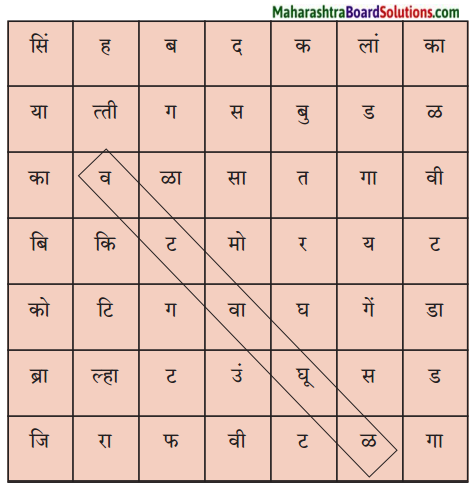
उदा. वटवाघूळ
उत्तरः
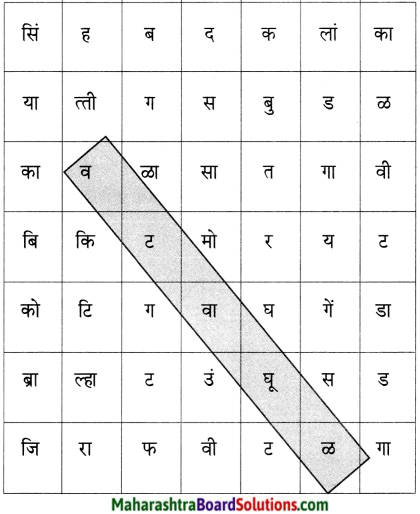
प्रश्न 2.
दवाखान्याचा ठिकाणी असलेल्या सुचनांच्या पाट्या तयार करा.
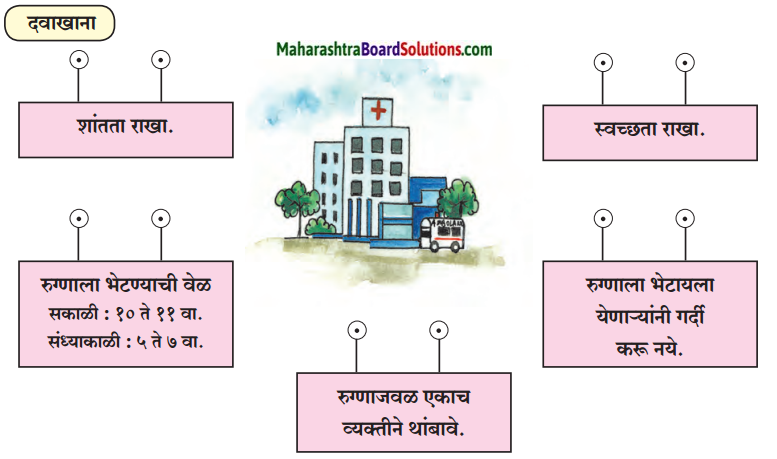
उत्तरः
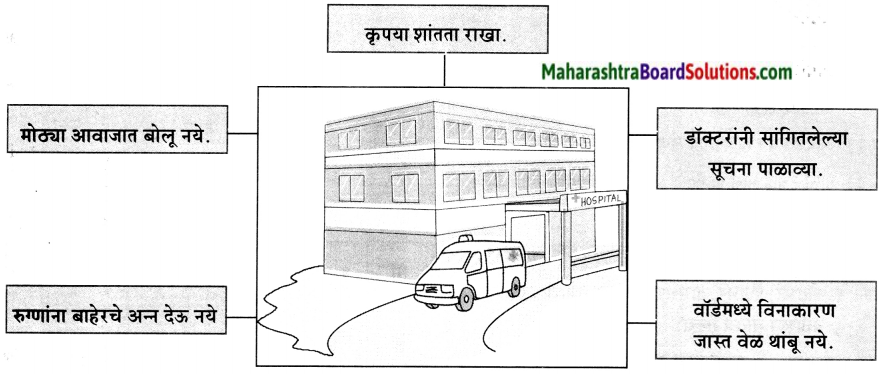
![]()
प्रश्न 3.
शाळेच्या परिसरात स्वच्छताविषयक कोणत्या पाट्या लावाल.
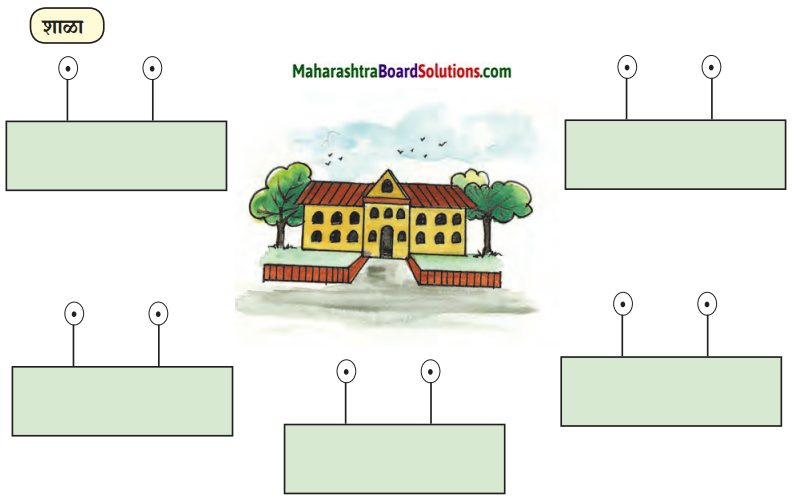
उत्तरः
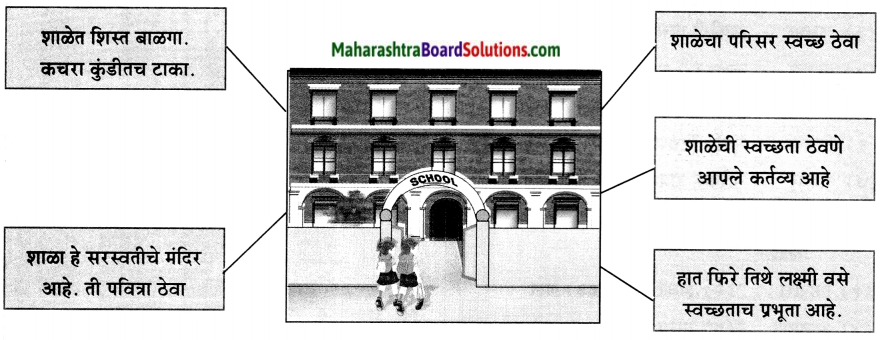
प्रश्न 4.
‘पर्यावरण संरक्षण’ याविषयी पाठाच्या शेवटी माणसाने केलेली प्रतिज्ञा तुमच्या शब्दात लिहा.
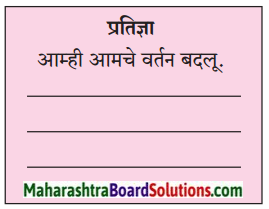
उत्तरः
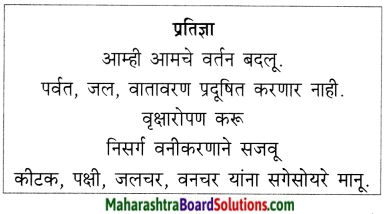
प्रश्न 5.
वाचा. समजून घ्या.
उत्तरः
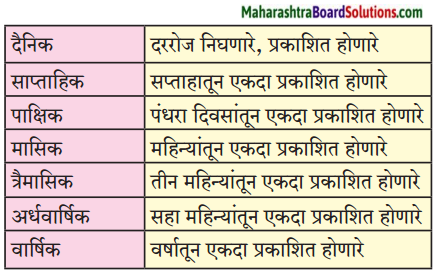
आपण समजून घेऊया.
प्रश्न 1.
खालील वाक्यांतील अधोरेखित शब्द पाहा.
- ही माझी छत्री आहे.
- तू कोणाचा मुलगा आहेस?
- मी कालच गावाहून आलो.
- जी वेगाने पळेल, ती जिंकेल.
प्रश्न 2.
अधोरेखित केलेले शब्द ‘एकाक्षरी’ शब्द आहेत. एकाक्षरी शब्दांना दयायची वेलांटी किंवा उ-कार नेहमी | दीर्घ लिहितात. या नियमाला फक्त ‘नि’ हा शब्द अपवाद आहे. खालील शब्दांपासून वाक्ये बनवा.
- ती –
- पी –
- मी –
- ही –
प्रश्न 3.
खालील शब्द वाचा. शब्दांतील शेवटच्या अक्षराला दिलेली वेलांटी, उ-कार समजून घ्या.
चिमणी, विळी, मिरची, कढई, चटई, सफाई, खिडकी, मागू, चिकू, पेरू, नाचू, वस्तू, गाऊ, शिंगरू, कांगारू, ताई, समई, पाहुणी, पाणी. मराठी भाषेत शब्दांतील शेवटच्या अक्षराला दयायची वेलांटी किंवा उ-कार नेहमी दीर्घ लिहितात. या नियमाला ‘आणि’, ‘परंतु’ हे शब्द अपवाद आहेत.
Class 6 Marathi Chapter 16 मुक्या प्राण्यांची कैफियत Additional Important Questions and Answers
दोन-तीन वाक्यांत उत्तरे लिहा.
प्रश्न 1.
माणसाने सगेसोयरे कोणाला म्हटले आहे?
उत्तर:
माणसाने कीटक, पक्षी, जलचर, वनचर यांना सगेसोयरे म्हटले आहे.
![]()
प्रश्न 2.
माणसाने प्राण्यांपाशी काय कबूल केले?
उत्तर:
पर्यावरणाचा केलेला हास माणसाच्या लक्षात आला. सर्व प्राणी तक्रार करू लागले. माणसाने तेव्हा यापुढे आम्ही आमचे वर्तन बदलू व पर्वत, जल, वातावरणात प्रदूषण करणार नाही असे सांगून वृक्षारोपण करू, वनीकरण करू असे ही आश्वासन दिले.
प्रश्न 3.
मानवाने केलेल्या प्रदूषणाचा कोणता दुष्परिणाम होईल, असे सर्व प्राण्यांनी सांगितले?
उत्तर:
प्राणी तक्रार करू लागले. मानवाने हवेचे, पाण्याचे, भूमीचे प्रदूषण केले. त्यामुळे वनचर आता तुझे सोयरे नाहीत. धरती माता दूषण देईल. मग माणूस दूध, अन्न पाण्यावाचून तडफडेल, असे सर्व प्राण्यांनी मानवाने केलेल्या प्रदूषणाचे दुष्परिणाम सांगितले.
व्याकरण व भाषाभ्यास
प्रश्न 1.
खालील शब्दांचे लिंग बदला.
- मोर
- सिंह
- गाय
- मांजर
- राघू
- कासव
- हरिण
उत्तर:
- लांडोर
- सिंहिण
- बैल
- बोका
- मैना
- कासविण
- हरिणी
![]()
प्रश्न 2.
खालील शब्दांचे लिंग बदला.
- गाय
- मासा
- जंगल
- पक्षी
- माणूस
उत्तर:
- गाई
- मासे
- जंगले
- पक्षी
- माणसे
हे लक्षात ठेवा:
एकाक्षरी शब्दांना दयायची वेलांटी किंवा उ-कार नेहमी दीर्घ लिहितात. अपवाद – ‘नि’.
प्रश्न 1.
खालील शब्दांपासून वाक्ये बनवा.
उत्तर:
- ती – ती खूप हुशार आहे.
- पी – तू पाणी पी.
- मी – मी अभ्यास करतो.
- ही – ही साडी छान आहे.
![]()
शब्दातील शेवटच्या अक्षराला दयायची वेलांटी किंवा उ-कार नेहमी दीर्घ लिहितात.
अपवाद – आणि, परंतु उदा. चिमणी, कढई, वस्तू, विक्री इ.
प्रश्न 2.
खालील शब्दांपासून वाक्ये बनवा.
उत्तर:
मिरची – पोपट मिरची खातो.
सफाई – दिवाळीत घरातील सफाई करतात.
चिकू – मला चिकू आवडतात.
गाऊ – आम्ही गाणे गाऊ.
प्रश्न 3.
कोण ते सांगा. (वनचर, भूचर, जलचर, उभयचर)
उत्तर:
पाण्यात राहणारे – जलचर
जमिनीवर राहणारे – भूचर
जंगलात राहणारे – वनचर
जमीन व पाणी या दोन्ही ठिकाणी राहणारे – उभयचर
![]()
प्रश्न 4.
खालील शब्दांचे विरूद्धार्थी शब्द पाठातून शोधून लिहा.
- प्रसन्न
- कठोर
- वेडा
- बिनविषारी
- स्वच्छ
- श्रद्धा
उत्तर:
- उदास
- नाजूक
- शहाणा
- विषारी
- घाण
- अंधश्रद्धा
मुक्या प्राण्यांची कैफियत Summary in Marathi
पाठपरिचयः
सदर पाठात पशू-पक्षी, जलचरांना मानवाकडून, त्याच्या अविचाराने होणारा त्रास वर्णन केला आहे. जलचर, भूचर त्रस्त आहेत. याचे दुष्परिणाम सर्व प्राणी मानवास जेव्हा सांगतात तेव्हा डोळे उघडतात. ‘पर्यावरण रक्षण’ कसे करावे हे यातून शिकता येते.
![]()
शब्दार्थ:
- कैफियत – तक्रार (complaint)
- वन – अरण्य, जंगल (forest)
- भीती – भय (fear)
- नाजक – कोमल (delicate)
- ढीग – रास (heap)
- पोटशूळ – पोट दुखणे (stomach ache)
- शहाणा – विवेकी (wise)
- जल – पाणी (water)
- विषारी – विषमिश्रीत (poisonous)
- वारूळ – मुंग्यांचे घर (ant hill)
- अंधश्रद्धा – चुकीच्या संकल्पना (superstition)
- हास – नष्ट (destruction)
- सोयरे – नातेवाईक (relatives)
- स्मरण – आठवण (remembrance)
- जागृत – सावध, जागरूक (to be aware of, vigilant)
- पर्यावरण – वातावरण (enviornment)
- वर्तन – आचरण (behaviour)
- वनीकरण – वन, जंगले वसविणे (forestation)
- वनचर – वनात फिरणारे प्राणी (wild animals)
- नच – नाही (no, not)
- वातावरण – आजूबाजूचा परिसर (atmosphere)
- प्रदूषण – दूषित करणे (pollution)
- हिरवेगार – गर्द हिरवे (greenish)
